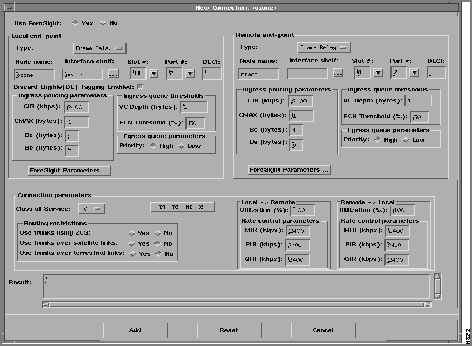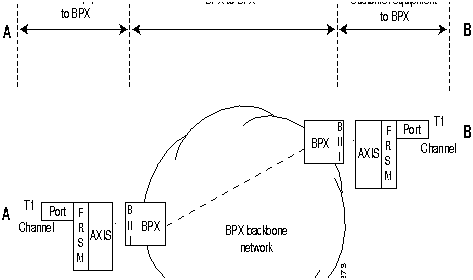|
|
Setting up a Frame Relay Connection
Setting up a frame relay connection is normally performed from StrataView Plus using the Connection Manager graphical user interface. An example of the StrataView Plus screen used for making an AXIS frame relay connection is shown below. For full details of how to set up a connection, refer to the StrataView Plus User's Manual.
Figure 5-1 : StrataView Plus Connection Manager Screen for AXIS

Via the Command Line Interface (CLI)
FRSM Network Interworking Connections
The following paragraphs describe how to establish an end-to-end frame relay connection assuming network interworking and AXIS FRSM end points.
Figure 5-2 shows two BPX nodes in a BPX network in which each of these two nodes is connected to an AXIS shelf via an BNI card. User frame relay equipment, located at "A", is attached to one of the AXIS shelves via a port on the shelf's FRSM card. Likewise, user frame relay equipment, located at "B", is attached to the other AXIS shelf. This chapter describes how a frame relay connection can to be established to permit bidirectional communication between the frame relay equipment at "A" and "B".
Figure 5-2 : Frame Relay Connection through an AXIS/BPX Network

In order to make the connection, the path from "A" to "B" is made up of three segments as shown in Figure 5-2. When using CLI, each segment must be established and configured separately.
Two segments span from the FRSM to the BNM on the AXIS shelves. These segments are part ATM and part frame relay with the conversion being made in the AXIS shelves.
There is also an ATM trunk segment that spans the BPX backbone network from one of the BPX nodes to the other BPX node, this segment terminates on a BNI feeder trunk in each node. This segment may include intermediary BPX nodes (not shown in the diagram).
The links between the segments must be configured properly so that the three segments make up one complete end to end connection from "A" to "B". This process consists primarily of ensuring that the VPI between the AXIS and it colocated BPX must contain the AXIS slot number of the FRSM and the VCI must contain the logical channel number assigned to the virtual circuit.
To establish an end to end frame relay connection, perform the following steps:
Establish the Customer Equipment to BPX Segments
This step must be performed on the AXIS at BOTH ends of the connection ("A" and "B").
On the AXIS:
At this point the AXIS segment is up with default parameters.
Establish the BPX to BPX Segment
Table 5-1 : Addcon parameters
| Parameter | Description |
|---|---|
| MCR | Minimum Cell Rate |
| PCR | Peak Cell Rate |
| % Util | Percentage utilization of channel |
Minimum Cell Rate (MCR) is only used with Foresight (ATFST).
MCR and Peak Cell Rated (PCR) should be specified according to the following formulae.
MCR = CIR *3/800 cells per second
PCR =AR * 3/800 cells per second but less than or equal to 6000
AR = Frame relay port speed in bps.
| For example: | AR equals 64K, PCR = 237, or
AR speed equals 256K, PCR = 950, or AR speed equals 1536K, PCR = 5703 |
The above MCR and PCR formulae assume a fairly pessimistic frame size of 100 octects, however, even smaller frame sizes can result in worse case scenarios. For example:
| For a frame size of 64 octects the PCR formula becomes | PCR = AR * 2/512 cells per sec |
| For a frame size of 43 octects the PCR formula becomes | PCR = AR * 2/344 cells per sec |
% Util should normally be set to the same value as that used for the frame relay segments of the connection.
FRSM Service Interworking Connections
FRSM service interworking connections are made in the same manner as the network interworking connections except that chan_type in the AXIS addchan command is specified as service interworking (transparent or translation) and the connection end that is remote from the AXIS is an ATM UNI.
These services are setup the same as frame relay except the for port_type in the addchan command which is set as 2 for FUNI or 3 for frame forwarding.
Setting up an AUSM connection is normally performed from StrataView Plus using the Connection Manager graphical user interface. An example of the StrataView Plus screen used for making an AXIS ATM to ATM connection is shown below. For full details of how to set up a connection, refer to the StrataView Plus User's Manual.
Figure 5-3 : ATM-ATM Connection Manager Screen

Via the Command Line Interface (CLI)
Use the following sequence of commands to establish an ATM UNI/NNI connection using the AUSM card. The connection is between a T1 or E1 ATM UNI on the AUSM card and an ATM service interface elsewhere in the IPX/BPX network.
For the BPX segment, set up the connection in the same manner as that for FRSM. The connection type should be specified as ABR, CBR, or VBR to match the connection type used at the connection endpoint (e.g., AUSM). The parameter values map directly from those specified at the connection endpoint.
|
|
Copyright 1988-1996 © Cisco Systems Inc.